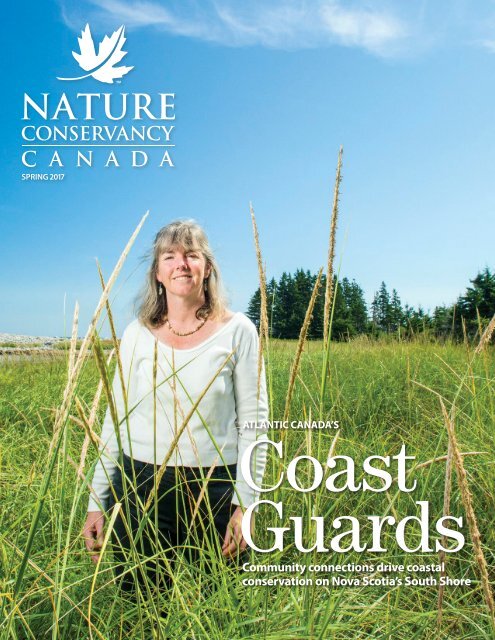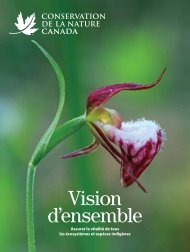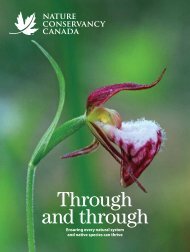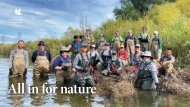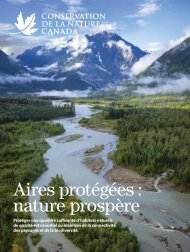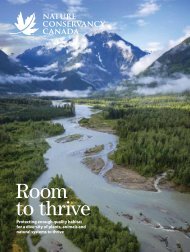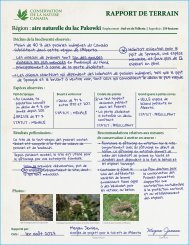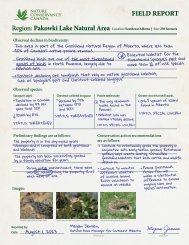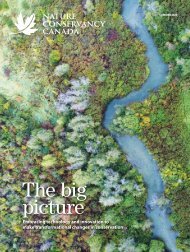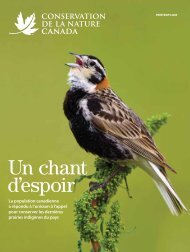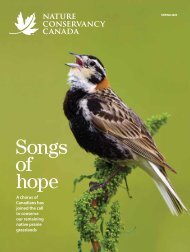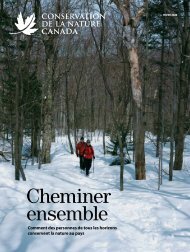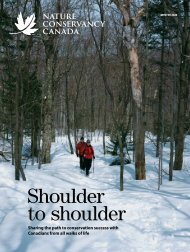NCC Magazine - Spring 2017
You also want an ePaper? Increase the reach of your titles
YUMPU automatically turns print PDFs into web optimized ePapers that Google loves.
SPRING <strong>2017</strong><br />
ATLANTIC CANADA’S<br />
Coast<br />
Guards<br />
Community connections drive coastal<br />
conservation on Nova Scotia’s South Shore
Nature Conservancy of Canada<br />
SPRING <strong>2017</strong><br />
Nature Conservancy of Canada<br />
36 Eglinton Avenue West, Suite 400<br />
Toronto, Ontario, Canada M4R 1A1<br />
magazine@natureconservancy.ca<br />
Phone: 416.932.3202<br />
Toll-free: 800.465.0029<br />
The Nature Conservancy of Canada (<strong>NCC</strong>)<br />
is the nation’s leading land conservation<br />
organization, working to protect our most<br />
important natural areas and the species<br />
they sustain. Since 1962, <strong>NCC</strong> and its partners<br />
have helped to protect 2.8 million acres (more<br />
than 1.1 million hectares), coast to coast.<br />
The Nature Conservancy of Canada <strong>Magazine</strong> is<br />
distributed to donors and supporters of <strong>NCC</strong>.<br />
TM<br />
Trademarks owned by the Nature Conservancy<br />
of Canada.<br />
FSC is not responsible for any calculations<br />
on saving resources by choosing this paper.<br />
Printed on Rolland Opaque paper, which<br />
contains 30% post-consumer fibre, is<br />
EcoLogo, Processed Chlorine Free certified<br />
and manufactured in Canada by Rolland<br />
using biogas energy. Printed in Canada with<br />
vegetable-based inks by Warrens Waterless<br />
Printing. This publication saved 29 trees and<br />
104,292 litres of water*.<br />
Design by Evermaven.<br />
COVER<br />
Danielle Robertson,<br />
Port Joli, Nova Scotia<br />
Photo by Aaron McKenzie Fraser.<br />
THIS PAGE<br />
Pointe Saint-Pierre, Quebec<br />
Photo by Mike Dembeck.<br />
TKTKTKTKTKTKT<br />
GENERATED BY: CALCULATEUR.ROLLANDINC.COM<br />
*<br />
2 SPRING <strong>2017</strong> natureconservancy.ca
Contents<br />
Nature Conservancy of Canada SPRING <strong>2017</strong><br />
TKTKTKTKTKTKT<br />
L-R, TOP TO BOTTOM: AARON MCKENZIE FRASER. SCOUTS CANADA. <strong>NCC</strong>.<br />
Hope and optimism<br />
Conservation is an effort of hope and<br />
optimism in the face of what can<br />
seem like unsurmountable obstacles.<br />
But just as the flap of a butterfly’s wings can<br />
have a large effect, so too can the actions of<br />
a single person buoyed by hope and optimism<br />
lead to great things.<br />
In the early sixties, J. Bruce Falls, a young<br />
zoology professor at the University of Toronto,<br />
was one of a small group of hopeful optimists<br />
who founded the Nature Conservancy of<br />
Canada (<strong>NCC</strong>). “We were seeing that many of<br />
the areas that we were interested in…were<br />
disappearing or being degraded,” said Falls<br />
in an interview a few years ago. “We thought,<br />
we’d better do something about it.”<br />
This past December, Falls’s contributions<br />
to Canadian conservation were recognized<br />
when he was named a member of the Order<br />
of Canada — a true testament to the impact<br />
of his hopeful vision more than 50 years ago.<br />
<strong>NCC</strong>’s president and CEO, John Lounds,<br />
was also recently recognized with the<br />
Museum of Nature’s 2016 Nature Inspiration<br />
Award. Lounds has guided <strong>NCC</strong> since 1997.<br />
His vision of <strong>NCC</strong> as a national conservation<br />
organization with offices in all 10 provinces<br />
has defined the scope of our work, and helped<br />
<strong>NCC</strong> evolve into Canada’s leading land<br />
conservation charity. We congratulate him<br />
and Bruce Falls on their recent awards.<br />
In the pages that follow, you’ll read stories<br />
about other hopeful, optimistic individuals,<br />
without whom <strong>NCC</strong>’s conservation achievements<br />
would not be possible. People like<br />
Danielle Robertson and Dirk van Loon, who<br />
believe in the importance of protecting the<br />
lands on which they live. We celebrate them,<br />
and we thank you for all you do to support<br />
our shared vision for a natural Canada.<br />
CBT<br />
Christine Beevis Trickett,<br />
Managing Editor<br />
8<br />
7 14<br />
14 Small Acts of<br />
Conservation<br />
Five ways you can help nature in your<br />
backyard or on your balcony<br />
16 Yellow Quill<br />
Prairie Preserve<br />
This grassland property in Manitoba<br />
bears traces of an ancient trade route<br />
17 Scouts Canada<br />
Backpack Essentials<br />
National youth commissioner<br />
Caitlin Piton’s backpack must-haves1<br />
18 Feature Story:<br />
Coastal Roots<br />
Conservation in Port Joli, Nova Scotia,<br />
begins with the community<br />
12 Eel-grass<br />
This member of the seagrass family is<br />
declining in many parts of its range<br />
14 Project Updates<br />
Four ways <strong>NCC</strong> staff are collaborating<br />
with ranchers and farmers in Manitoba,<br />
Saskatchewan, Alberta and B.C.<br />
16 Richard Ivey:<br />
Family Values<br />
The Ivey family’s leadership has inspired<br />
conservation across Canada<br />
18 Remembering<br />
Stuart McLean<br />
A special story about one of <strong>NCC</strong>’s<br />
conservation projects, à la Vinyl Cafe<br />
natureconservancy.ca<br />
SPRING <strong>2017</strong> 3
COAST TO<br />
COAST<br />
Small Acts of<br />
Conservation<br />
Five things you can do right now to help<br />
nature in your backyard or on your balcony<br />
Many of us steward a small piece of Canada. It could be a recreational<br />
property or a few square metres in an urban backyard. While these<br />
places are not a wilderness or a wildlife preserve, they are all still a part<br />
of nature, and they have a role in conservation.<br />
Here’s a checklist of five small acts of conservation we can all<br />
take to help nature, which will also benefit you and your community.<br />
GETTY IMAGES.<br />
4 SPRING <strong>2017</strong> natureconservancy.ca
COAST TO<br />
COAST<br />
2<br />
4<br />
ISTOCK.<br />
1Be for<br />
the birds<br />
The Baltimore oriole or<br />
scarlet tanager on your<br />
property today may have<br />
been in Venezuela when<br />
you were shoveling snow or<br />
skiing. Every year, billions of<br />
songbirds make the journey<br />
to Canada for one simple<br />
reason: the explosion of<br />
life that happens in our<br />
northern spring makes it a<br />
great place to raise a family.<br />
Sadly, migratory songbirds<br />
have been rapidly declining.<br />
While many species remain<br />
common, they are at risk<br />
because of steep population<br />
declines. For example,<br />
the wood thrush and barn<br />
swallow are both considered<br />
at risk because their populations<br />
in Canada have<br />
declined by more than<br />
75 per cent since 1970.<br />
You can help by creating<br />
migratory bird pit-stops<br />
on your property. Planting<br />
clusters of native shrubs or<br />
trees can provide important<br />
habitat. If every Canadian<br />
with a single-detached<br />
house provided just one<br />
small patch of vegetation for<br />
songbirds in their yard, we’d<br />
add more than 7 million new<br />
sites for nesting and resting.<br />
Soak it<br />
all in<br />
On many yards and<br />
properties, water no longer<br />
sits and soaks into the<br />
ground, but runs off roofs,<br />
driveways, fields and lawns<br />
into drains and eventually<br />
into our streams and lakes.<br />
One of the biggest issues for<br />
Canada’s freshwater is too<br />
much runoff, which carries<br />
sediments, nutrients and<br />
pollutants into our streams<br />
and lakes. This can clog<br />
streams with silt and cause<br />
algal blooms in even very<br />
big lakes, such as Lake Erie<br />
and Lake Winnipeg.<br />
Where you can, slow the<br />
flow. Hold water on your<br />
property in rain barrels, rain<br />
gardens, wetlands or other<br />
natural habitats. Make sure<br />
the water that leaves your<br />
property is as clean as it can<br />
be. Remember, the more<br />
water that infiltrates the<br />
ground on your property,<br />
the more you are helping<br />
to conserve Canada’s<br />
freshwater habitats.<br />
3Cover it up<br />
A study on the benefits of<br />
conserved forests by TD<br />
Bank Group and the Nature<br />
Conservancy of Canada<br />
(<strong>NCC</strong>) found that an acre<br />
of conserved forest can<br />
provide up to $18,000 in<br />
important services, such as<br />
reducing floods, removing<br />
air pollution and sequestering<br />
carbon, every year.<br />
Not only are trees the<br />
original (and still the best)<br />
carbon capture and storage<br />
method ever developed,<br />
they literally create habitat<br />
in what was once thin air.<br />
When we fill that space<br />
above our heads with<br />
limb and leaf, we create<br />
new habitats.<br />
There are millions of places<br />
in our cities and around our<br />
homes that could support<br />
more trees. If you can, find<br />
a place to plant a native tree<br />
on your property, or support<br />
a forest restoration project<br />
at <strong>NCC</strong>. You’ll be helping<br />
create important habitats,<br />
and making the world<br />
a cooler place.<br />
Know<br />
your place<br />
Unfortunately, particularly<br />
for the eight in 10 Canadians<br />
who live in cities, we are<br />
losing our nature knowledge,<br />
and with it, an understanding<br />
of our connectedness<br />
to other living things and<br />
the natural world.<br />
The good news is that<br />
learning about nature<br />
is getting easier. While a<br />
walk through the woods<br />
or grasslands with an elder<br />
or experienced naturalist<br />
may still be the best way to<br />
learn, a few clicks on the<br />
internet can reveal not only<br />
the species in and around<br />
your home, but also how to<br />
identify them.<br />
Even learning about five<br />
new species a year can<br />
change the way you see the<br />
world. As you get to know<br />
wild things, they start to<br />
reveal themselves. What<br />
appears as a blanket of<br />
forest or prairie becomes<br />
a richer tapestry of life.<br />
Join us! This year’s Conservation<br />
Volunteers season launches April 24!<br />
conservationvolunteers.ca<br />
5Leave<br />
some wild<br />
Our challenge in Canada is<br />
that while we have the rare<br />
opportunity to protect some<br />
of the world’s last true<br />
wilderness in our northlands,<br />
we have lost significant<br />
amounts of our natural<br />
habitats in the south where<br />
most people live. This loss<br />
impacts both nature and<br />
the well-being of Canadians.<br />
We have nature in our cities<br />
and homes. It may not be<br />
the same nature that was<br />
there hundreds of years ago,<br />
but it can provide important<br />
habitat. There are hundreds<br />
of species that will share our<br />
space, if we provide room<br />
for them. This year, create or<br />
expand a small area of wild<br />
on your property and enjoy<br />
your nature neighbours.1<br />
natureconservancy.ca<br />
SPRING <strong>2017</strong> 5
BOOTS ON<br />
THE TRAIL<br />
Learning about prairie skinks<br />
Visitors to this Manitoba property<br />
may still be able to catch a glimpse<br />
of a historic trade route.<br />
Yellow Quill<br />
Prairie Preserve<br />
This native mixed-grass prairie area in Manitoba conserves<br />
nature and our shared history of the land<br />
Ruffed grouse<br />
Long before European explorers and<br />
settlers arrived in North America,<br />
indigenous peoples had defined the<br />
most convenient routes to travel the landscape.<br />
Among them, the Yellow Quill Trail (named for<br />
Chief Yellow Quill of the Saulteaux First Nation<br />
during the late 1800s) connected Portage la<br />
Prairie, west of Winnipeg, with the Boundary<br />
Commission Trail, just past the western<br />
Saskatchewan border. Later, these trade routes<br />
were adopted by European settlers.<br />
Today, the Yellow Quill Prairie Preserve,<br />
south of Brandon in Manitoba, still bears faint<br />
traces of the Yellow Quill Trail. Here, the trail<br />
passes through a rolling, sandy prairie of<br />
mixed grasses, such as big and little bluestem,<br />
green needle grass and porcupine grass,<br />
interspersed with hazelnut, juniper, aspen, bur<br />
oak and white spruce.<br />
A NATURAL FAMILY LEGACY<br />
The Mooneys, fourth-generation descendants<br />
of the European pioneers who settled in the<br />
area in 1885, were the original owners of most<br />
of the lands: 1,440 acres (580 hectares) within<br />
the Yellow Quill project area. The family has<br />
leased the remaining 960 acres (390 hectares)<br />
from the provincial government.<br />
Over time, conversion of the neighbouring<br />
native grasslands all but eliminated these<br />
once-large tracts of native grasslands. But the<br />
Mooneys knew the ecological value of their<br />
lands. After being approached by <strong>NCC</strong>, they<br />
decided to fulfill the wishes of their departed<br />
father by selling the land to <strong>NCC</strong> in the<br />
hopes that their mixed-grass prairie would<br />
not be lost.<br />
<strong>NCC</strong> purchased the lands from the<br />
Mooney family in 1999. Shortly after completing<br />
the purchase, <strong>NCC</strong> developed a management<br />
plan that incorporated traditional cattle<br />
grazing practices to maintain biodiversity.<br />
LANDSCAPE: <strong>NCC</strong>. SKINK: <strong>NCC</strong>. GROUSE: ROBERT MCCAW.<br />
6 SPRING <strong>2017</strong> natureconservancy.ca
BACKPACK<br />
ESSENTIALS<br />
Today, these areas continue to shelter native<br />
mixed-grass prairie.<br />
In 2016, <strong>NCC</strong>’s Manitoba Region expanded<br />
the original project with the addition of<br />
a further 320 acres (130 hectares).<br />
A UNIQUE LANDSCAPE<br />
These lands, nestled along the western<br />
boundary of the Assiniboine Delta in south<br />
central Manitoba, are representative of the<br />
vast prairies that once extended across<br />
southern Manitoba. The landforms resulted<br />
from the deposits of sediment in the delta,<br />
where the Assiniboine River flowed into<br />
glacial Lake Agassiz. As the waters receded<br />
about 10,000 years ago, the sediments were<br />
shaped into sandhill complexes, which remain<br />
the dominant feature on the landscape today.<br />
The unique sandhill landscape and occasional<br />
open dunes are some of the last refuges<br />
in the province where rare sandhill species<br />
exist. Over time, lack of disturbance has caused<br />
the historically open dunes to stabilize with<br />
the roots of plants and grasses. <strong>NCC</strong> staff are<br />
working to implement management programs<br />
that promote the stewardship and recovery of<br />
dune complexes, an important and increasingly<br />
rare ecosystem type in Manitoba.<br />
Visitors to the property may spot elk,<br />
coyote, moose, deer and fox. The Yellow<br />
Quill Prairie Preserve is a preferred site for<br />
birdwatchers wishing to see red-tailed hawk,<br />
ruffed grouse, sharp-tail grouse and mountain<br />
bluebird. It’s also important habitat for the<br />
endangered prairie skink.<br />
1<br />
5<br />
4<br />
Scout’s honour<br />
Caitlyn Piton, national youth commissioner & chair of<br />
Scouts Canada’s National Youth Network, shares her<br />
backpack must-haves<br />
3<br />
2<br />
ITEMS: JUAN LUNA. CAITLYN PITON: SCOUTS CANADA.<br />
TRAILS<br />
Length: approximately 4.5 km of access trails<br />
Difficulty: easy<br />
Terrain: rolling sandhills and native grasslands<br />
GETTING THERE<br />
The property is located 20 kilometres southeast<br />
of Brandon and two kilometres north of the<br />
junction of the Souris and Assiniboine rivers. It<br />
abuts the western boundary of the Canadian<br />
Forces Base Shilo. Visitors are asked to call<br />
1-866-683-6934 prior to visiting to ensure land<br />
management activities are not active on-site.A<br />
DOWNLOAD THE TRAIL MAP<br />
Visit natureconservancy.ca/yellowquill<br />
to download a trail map and directions.<br />
1. BEEF JERKY I tend to<br />
get hungry fairly easily,<br />
so a quick snack is<br />
a must or I might get<br />
grumpy (as my<br />
team knows).<br />
2. WATER FILTER<br />
This is much easier<br />
than having to carry<br />
around bottles of water,<br />
if there are streams along<br />
your way.<br />
3. LOOSE LEAF TEA I don’t think I could<br />
go a day without tea. It’s nice to have<br />
something comforting,<br />
especially if it’s raining<br />
(which it does a lot<br />
in Vancouver, where<br />
I’m from).<br />
4. FIRST AID KIT<br />
I’m a klutz, so this is<br />
an absolute must.<br />
5. KNIFE I have a knife<br />
that I absolutely love. It<br />
has engraving on it from some<br />
of the work I’ve done with Scouts<br />
Canada and is the most useful thing<br />
I’ve ever received!1<br />
natureconservancy.ca<br />
SPRING <strong>2017</strong> 7
Coastal<br />
roots<br />
A love for nature that runs<br />
as deep as the waters off<br />
Nova Scotia’s South Shore<br />
drives coastal conservation<br />
from the grassroots up<br />
BY Sandra Phinney<br />
PHOTOGRAPHY Aaron McKenzie Fraser<br />
TKTKTKTKTKTKT<br />
8 SPRING <strong>2017</strong> natureconservancy.ca
Danielle Robertson has<br />
had a love affair with nature in<br />
general, and Port Joli, Nova<br />
Scotia, in particular, for as long as she can<br />
remember. Her roots run deep, as do those<br />
of her husband, Charles. The land they live<br />
on in Port Joli, nestled along Nova Scotia’s<br />
South Shore, has been in the family since 1786,<br />
when early settlers fished and farmed here.<br />
“You can still see old fence posts<br />
that were used to build platforms on the<br />
coastal marsh where they stored the hay,”<br />
says Robertson.<br />
Yet the places their ancestors knew and<br />
cared for over generations are increasingly<br />
under threat from habitat loss, climate change<br />
and the encroachment of invasive species,<br />
such as European green crab. Given that<br />
Canada’s East Coast is projected to experience<br />
rising sea levels of up to one metre by the end<br />
of the century, it comes as no surprise that the<br />
potential impacts of this latter threat on our<br />
coastal ecosystems and coastal communities<br />
are staggering.<br />
<strong>NCC</strong> has conserved close to 340 kilometres of marine coastal habitat in Canada, including here at Port Joli, Nova Scotia.<br />
For an interactive map showing the timeline of <strong>NCC</strong>’s work in Port Joli, visit: natureconservancy.ca/port-joli<br />
TKTKTKTKTKTKT<br />
natureconservancy.ca<br />
SPRING <strong>2017</strong> 9
One of the ways to safeguard these places,<br />
for the people and species that live in them, is<br />
for conservation organizations like the Nature<br />
Conservancy of Canada (<strong>NCC</strong>) to work with<br />
people on the ground at the grassroots level.<br />
Support from local champions like Danielle<br />
Robertson and her family — people who are<br />
innately tied to the land and its history — is<br />
critical in helping ensure a future for these<br />
coastal landscapes.<br />
Robertson has spent decades digging her<br />
roots deeper, getting to know the natural<br />
and human history of Port Joli. Shortly after<br />
graduating from Mount Saint Vincent University<br />
in 1989, Robertson was hired to do research<br />
for the nearby Thomas Raddall Provincial<br />
Park, which further fuelled her passion for the<br />
region. In the process, she researched the<br />
park’s Mi’kmaq clam middens (areas where<br />
First Nations would dispose of clam shells<br />
after harvesting them), evidence of a rich<br />
human history dating back thousands of years.<br />
“I got obsessed with the sites,” she says,<br />
“and I also got serious about conservation.”<br />
Robertson was proud that Port Joli and<br />
neighbouring Port L’Hebert had four parks,<br />
It’s getting more and more important that Canada be<br />
the kind of country that protects the flora and fauna,<br />
and where you can go out into the wild and explore.<br />
DIRK VAN LOON (CENTRE, ABOVE ) BECAME A LAND DONOR AFTER DANIELLE ROBERTSON (OPENING<br />
SPREAD) OPENED THE DOOR TO WORKING WITH <strong>NCC</strong>.<br />
a nature reserve and three migratory bird<br />
sanctuaries that were protected from development<br />
and managed by national and provincial<br />
government agencies — signs of the area’s<br />
natural and cultural significance. Yet she often<br />
thought how wonderful it would be for her<br />
family and next generations if even more<br />
land in the region could be protected from<br />
extensive housing developments, quarries<br />
and clear cutting.<br />
Thirteen years ago, she and Charles<br />
contacted <strong>NCC</strong>. Would the organization be<br />
interested in buying a piece of the Robertson<br />
family’s property if they donated a parcel?<br />
Shortly after opening the door, Robertson also<br />
provided contact information to <strong>NCC</strong> staff for<br />
other landowners in hopes that, down the<br />
road, <strong>NCC</strong> could help secure other lands in<br />
the area. And that’s exactly what transpired.<br />
Local champions<br />
Craig Smith, Nova Scotia program director with<br />
<strong>NCC</strong>, says that a number of factors influence<br />
whether the land conservation organization<br />
pursues work in a natural area or not.<br />
“One of them is: do you have local champions?<br />
When the Robertsons placed the call to<br />
us, it happened to coincide with <strong>NCC</strong> completing<br />
a survey of this region,” says Smith. <strong>NCC</strong>’s<br />
staff had identified southwest Nova Scotia<br />
as one of the areas that stood out as being<br />
particularly ecologically important because of<br />
its forests, diversity and rich coastal habitats.<br />
Another of the many special features of<br />
the area is that endangered mainland moose<br />
living in the Tobeatic Wilderness Area migrate<br />
to the Port Joli peninsula in the summer<br />
— perhaps for the cooler climate and for the<br />
salt content of the coastal marshes. Also, this<br />
10 SPRING <strong>2017</strong> natureconservancy.ca
AERIAL: MIKE DEMBECK.<br />
region is part of the South Shore (Port Joli<br />
sector) Important Bird Area, which provides<br />
valuable habitat for migrating shorebirds<br />
and waterfowl, and nesting habitat for the<br />
endangered piping plover.<br />
“Property owners like Danielle can be<br />
extremely helpful to bridge the divide and<br />
create a more nuanced understanding among<br />
other landowners about who we are and<br />
what we do,” Smith says.<br />
That knowledge of <strong>NCC</strong> came in handy<br />
when Robertson approached a neighbouring<br />
landowner, Dirk van Loon, who had moved<br />
to the area from the United States in 1969. He<br />
and his wife bought an old farm in Port Joli,<br />
where he homesteaded, wrote books and<br />
started a magazine.<br />
“Where I grew up back in the U.S. is now<br />
all developed. There is no wilderness there<br />
anymore,” says van Loon. “So it’s getting more<br />
and more important that Canada be the kind<br />
of country that protects the flora and fauna, and<br />
where you can go out into the wild and explore.”<br />
Many years ago, van Loon and two other<br />
like-minded families acquired 180 acres (70<br />
hectares) in Port Joli on the spectacular Sandy<br />
Bay Beach. They wanted to ensure the beach<br />
remained natural and undeveloped. Van Loon<br />
later handed down his portion of the beach to<br />
his son, and together, because of a shared ethic,<br />
the group of Sandy Bay landowners worked<br />
with <strong>NCC</strong> to bring the beach into conservation.<br />
In 2015, van Loon sold a substantial piece of<br />
his land in the same area to <strong>NCC</strong>.<br />
The lands around Sandy Bay Beach have<br />
humid coastal forests, rare lichens and lots of<br />
Craig Smith, <strong>NCC</strong>’s Nova Scotia program director, surveys the coastline.<br />
wildlife. “I blame Danielle Robertson for<br />
getting us involved,” van Loon jokes. “She<br />
opened the door to working with <strong>NCC</strong>.”<br />
Now, <strong>NCC</strong> protects 1,627 acres (658<br />
hectares) in Port Joli and its surrounding<br />
region, thanks to landowners such as the<br />
Robertsons and van Loon, who know the<br />
land on which they live is a special place.<br />
Historical connections<br />
It’s now clear that this understanding of the<br />
area’s ecological richness was shared by First<br />
Nations communities that lived here thousands<br />
of years ago. Port Joli was a cultural landscape,<br />
where people expressed their customs as well<br />
as made a living.<br />
“In Port Joli, we’ve found hard evidence<br />
that the place was an ecological node (a place<br />
of special ecological diversity and productivity),”<br />
says Matthew Betts, PhD, and curator,<br />
eastern archaeology with the Canadian Museum<br />
of History. “The Mi’kmaq lived on the coast<br />
all year round, as opposed to the traditional<br />
model of spending winters in the interior and<br />
summers on the coast.”<br />
In Nova Scotia, where 90 per cent of<br />
the coastline is privately owned, these local<br />
connections with people who know the<br />
land are ever more important if these special<br />
places are to be protected. As <strong>NCC</strong> continues<br />
to conserve lands and waters across the<br />
country, working with people on the ground<br />
who have deep roots, like the Robertsons<br />
and van Loon, provides an excellent model<br />
of what can be done if Canadians<br />
work together.1<br />
PRESSURE RISING ON<br />
CANADA’S COASTS<br />
With over a quarter of a million<br />
kilometres of beaches, rocky shores,<br />
salt marshes, seagrass meadows and<br />
sea cliffs, Canada has more coastline<br />
than the U.S. and Russia combined.<br />
Canada’s coasts are the ecological<br />
interface between land and sea, and<br />
are equally essential for shorebirds<br />
and the close to 1,100 fish species<br />
that live in nearshore waters.<br />
Many coastal habitats are very sensitive.<br />
In addition to direct pressures, such<br />
as unsustainable recreational uses and<br />
invasive species, the health of coasts<br />
often reflects the health of surrounding<br />
lands and marine waters.<br />
TKTKTKTKTKTKT<br />
Climate change is increasing the<br />
pressures on our coasts. Rising sea<br />
levels and extreme storm surges are<br />
changing the forces that have shaped<br />
coastal ecosystems. Across Canada,<br />
<strong>NCC</strong> is incorporating climate change<br />
impacts into our conservation actions<br />
to increase the resiliency of coastal<br />
habitats and to buffer coastal<br />
communities from the impacts<br />
of climate change.<br />
natureconservancy.ca<br />
SPRING <strong>2017</strong> 11
SPECIES<br />
PROFILE<br />
Eel-grass<br />
This unassuming species plays a major role in Canada’s coastal ecosystems<br />
MARTIN ALMQVIST/ALAMY/ALL CANADA PHOTOS.<br />
12 SPRING <strong>2017</strong> natureconservancy.ca
Eel-grass, a type of seagrass, first evolved as an aquatic algae,<br />
moved to land and then returned to the ocean. Its long,<br />
bright-green blades resemble underwater ribbons. The<br />
plant’s complex root system allows it to anchor itself to the floors of<br />
shallow bays, coves, lagoons and estuaries. By filtering and trapping<br />
sediment, pollutants and nutrients, the species helps improve water<br />
quality. Eel-grass beds support many marine invertebrates and provide<br />
spawning and nursery habitat for numerous fish, resulting in<br />
important feeding areas for marine birds and mammals.<br />
STRUCTURE AND REPRODUCTION<br />
Often mistaken for seaweed, eel-grass differs from it in several ways. For example,<br />
unlike seaweed, eel-grass roots not only anchor the plants, they also absorb<br />
nutrients. Eel-grass also has flowers and veins.<br />
Eel-grasses reproduce in two ways: asexually, through cloning, and sexually,<br />
by producing seeds. Like land grasses, eel-grass shoots are interconnected through<br />
an underground rhizome (a large, root-like structure) network. As rhizomes spread,<br />
they create new shoots that are clones of one another.<br />
To reproduce sexually, male eel-grass flowers release pollen into the water,<br />
which is then moved by underwater currents. The pollen grains, which are<br />
the longest of any plant species in the world, then fertilize female flowers and<br />
produce seeds.<br />
A SENSITIVE SPECIES<br />
Eel-grass is highly susceptible to human interference. Shade from docks, floating log<br />
booms and algae also threaten this species. “Wasting disease,” caused by a marine<br />
slime mold, affects some Atlantic populations. A relatively recent threat to eel-grass<br />
is the European green crab — an invasive species that arrived in Atlantic Canada<br />
in the 1950s in the ballast water of ships — which cuts the grasses while digging in<br />
sediment for food.<br />
FACT SHEET<br />
SCIENTIFIC NAME<br />
Zostera marina<br />
SIZE AND WEIGHT<br />
Can reach lengths of up to 1 m.<br />
RANGE<br />
North America’s Atlantic and Pacific<br />
coasts, as well as Hudson Bay.<br />
POPULATION TREND<br />
Globally, eel-grass meadows have<br />
declined on average by about<br />
seven per cent per year since 1990.<br />
Some declines along Canada’s B.C.<br />
coast could have resulted from the<br />
introduction of the non-native Pacific<br />
oyster to the wild. In Newfoundland<br />
and Labrador, eel-grass abundance<br />
has increased over the past decade.<br />
STATUS IN CANADA<br />
No official status. NatureServe ranks it<br />
as imperilled in Ontario and Manitoba,<br />
and vulnerable in Quebec and Newfoundland<br />
and Labrador.<br />
DID YOU KNOW?<br />
Seagrasses are estimated to be<br />
responsible for 15 per cent of the total<br />
carbon storage in the ocean, even<br />
though they occupy only 0.2 per cent<br />
of the oceans.<br />
SCOTT LESLIE/MINDEN PICTURES.<br />
CONSERVATION EFFORTS<br />
The Nature Conservancy of Canada (<strong>NCC</strong>) is protecting eel-grass habitat along<br />
Canada’s Atlantic and Pacific coasts. In 2014, staff in Nova Scotia partnered with<br />
the Province of Nova Scotia and used aircraft and satellite imagery to map and<br />
monitor eel-grass beds in the Pugwash Estuary and Musquodoboit Harbour. The<br />
following year, <strong>NCC</strong> trapped European green crabs at the Pugwash Estuary to<br />
determine this invasive species’ population size. In addition, <strong>NCC</strong> has acquired<br />
valuable coastal land along Nova Scotia’s Northumberland Strait, which includes<br />
important eel-grass beds.<br />
<strong>NCC</strong> has also protected upland areas around estuaries in New Brunswick, such<br />
as those at Tabusintac, where research is being conducted on eel-grass. Meanwhile,<br />
in Quebec's Malbaie salt marsh, <strong>NCC</strong> has conserved a property that shelters an<br />
eel-grass colony. Black ducks make stopovers here during their migration, to feed<br />
on the plant.<br />
In British Columbia, <strong>NCC</strong> has helped restore eel-grass populations in the<br />
Campbell River Estuary on Baikie Island by replanting native vegetation in<br />
marshes along rivers and streams. <strong>NCC</strong> staff have also identified eel-grass beds<br />
as a priority habitat for coastal conservation projects, such as Grace Islet,<br />
Clayoquot Island and the Gullchucks Conservation Area.1<br />
CRABBY TIME<br />
Green crabs are an invasive species that<br />
is now established in many locations<br />
in North America and is still expanding<br />
its range.<br />
Learn more at natureconservancy.ca/<br />
green-crab<br />
natureconservancy.ca<br />
SPRING <strong>2017</strong> 13
PROJECT<br />
UPDATES<br />
1<br />
Cows and conservation<br />
ACROSS CANADA<br />
2<br />
3<br />
1<br />
4<br />
WANT TO LEARN MORE?<br />
Visit natureconservancy.ca/en/where-we-work<br />
to learn more about these and other <strong>NCC</strong> projects.<br />
What do cows and conservation have in common? The Nature<br />
Conservancy of Canada’s (<strong>NCC</strong>’s) membership in the Canadian<br />
Roundtable for Sustainable Beef (CRSB) is just one example of the<br />
many ways that <strong>NCC</strong> has established tangible working relationships<br />
with farmers and ranchers.<br />
The CRSB, a multi-stakeholder initiative focused on advancing<br />
sustainability within the Canadian beef industry, has established five<br />
key guiding principles. Among them is the goal of ensuring that beef<br />
producers adopt practices that sustain and restore ecosystem health.<br />
CRSB’s other principles include respect for people and the community,<br />
animal health and welfare, food quality, efficiency and innovation.<br />
Since 2015, <strong>NCC</strong> has provided technical and financial support to<br />
the CRSB to develop indicators that help ensure that the health of the<br />
grasslands in which ranchers graze livestock is maintained and, wherever<br />
possible, enhanced. <strong>NCC</strong> has also supported the CRSB’s development<br />
of a set of important environmental goals, including the enhancement<br />
of ecological services (such as flood control), improvement of stream<br />
health and reduction of the industry’s water and greenhouse gas<br />
footprints. <strong>NCC</strong> believes that the achievement of these goals is vital<br />
to the conservation of biodiversity.<br />
<strong>NCC</strong> understands that our conservation work cannot operate in<br />
isolation, and that effective conservation needs partnerships. Our<br />
partnership with the CRSB will help positively influence biodiversity<br />
and ecosystem health within these working landscapes, on a very<br />
large and ecologically significant scale.<br />
<strong>NCC</strong> believes partnerships are essential to effective conservation, and works with<br />
farmers and ranchers to ensure the sustainable management of Canada’s grasslands.<br />
INSET: <strong>NCC</strong>. LANDSCAPE: <strong>NCC</strong>.<br />
14 SPRING <strong>2017</strong><br />
natureconservancy.ca
<strong>NCC</strong> and the Frolek family have worked<br />
together for close to a decade to protect<br />
this grassland habitat near Kamloops, B.C.<br />
2<br />
Conservation-minded ranchers<br />
KAMLOOPS, BRITISH COLUMBIA<br />
Each summer, Barb Pryce and Ray Frolek head out into the grasslands near Kamloops,<br />
British Columbia, to check up on <strong>NCC</strong>’s conservation projects there. <strong>NCC</strong> and the Frolek<br />
Cattle Company have been collaborating on grassland conservation since 2008, when the<br />
B.C.<br />
two joined forces to conserve 7,828 acres (3,168 hectares) of this rare and ecologically<br />
significant habitat.<br />
“As a third-generation rancher, Ray sees how the land has changed over time,” says Pryce.<br />
“His understanding of past conditions adds important context to what we are seeing now.”<br />
Ranchers own a lot of private land in B.C.’s rare grassland valleys. Partnering with<br />
conservation-minded ranchers is essential to conserving this important habitat.<br />
“Our relationships with ranchers enable truly amazing conservation in Canada’s grasslands,” says Pryce.<br />
“We couldn’t do this work without them!”<br />
Partner<br />
Spotlight<br />
In 2014, Imperial pledged<br />
$1 million over four years to the<br />
Nature Conservancy of Canada<br />
(<strong>NCC</strong>) in support of the National<br />
Conservation Interns Program.<br />
The work of <strong>NCC</strong>’s conservation<br />
interns is diverse, ranging from<br />
forest and grassland restoration,<br />
to species inventories, trail maintenance<br />
and access. Interns can<br />
also participate in mapping with<br />
geographic information systems,<br />
data management, monitoring<br />
and relationship building with<br />
neighbours, stakeholders and<br />
communities.<br />
FROLEK FAMILY AND <strong>NCC</strong> STAFF: TESSA BUCHAN. CONSERVATION INTERN: <strong>NCC</strong>.<br />
3<br />
Home on the range<br />
TWIN BUTTE, ALBERTA<br />
This past summer, <strong>NCC</strong>’s Alberta Region teamed up with a group of rangeland experts to<br />
learn the tricks of the ranching trade. The Rancher’s Rangeland Management Workshop<br />
was held at the Twin Butte Community Hall. The two-day workshop was attended by <strong>NCC</strong><br />
staff, and landowners and ranchers from the surrounding communities.<br />
Presenters included government experts, academics, private consultants and the<br />
landowners themselves. Participants discussed a wide range of topics, including principles<br />
of range management, grazing strategies, weed control and prevention, ecological<br />
services of grasslands and reducing wildlife-livestock conflicts.<br />
4<br />
A new lease on life<br />
WIDEVIEW, SASKATCHEWAN<br />
One of <strong>NCC</strong>’s newest properties in southwest Saskatchewan, Wideview, is now being grazed<br />
by a local rancher’s cattle. <strong>NCC</strong> creates these types of lease agreements on about 90 per cent<br />
of our properties in Saskatchewan, as a way of managing biodiversity while developing good<br />
relationships with our neighbours.<br />
Grazing by domestic cattle simulates the natural processes by which these grasslands<br />
would have historically been influenced by wildfire and herds of bison. This grazing, in<br />
turn, increases biodiversity and fertilizes the soil with manure. <strong>NCC</strong> monitors the grass to<br />
ensure that grazing is maintaining and improving the health of the prairie ecosystem.1<br />
ALTA.<br />
SASK.<br />
“<strong>NCC</strong>’s Conservation Interns<br />
Program provides outstanding<br />
experiences for university and<br />
college students in areas such as<br />
conservation science, land management<br />
and wildlife research,”<br />
says Erica Thompson, <strong>NCC</strong>’s<br />
senior director for national<br />
conservation engagement<br />
and development.<br />
Imperial is an integrated energy<br />
company committed to developing<br />
our nation’s resources responsibly.<br />
Working with partners like <strong>NCC</strong> to<br />
invest in tomorrow’s conservation<br />
leaders delivers a valuable, longterm<br />
contribution to Canada.<br />
Kim Fox<br />
Vice President of Public and<br />
Government Affairs, Imperial<br />
natureconservancy.ca<br />
SPRING <strong>2017</strong> 15
FORCE FOR<br />
NATURE<br />
Family values<br />
Richard Ivey’s love for nature and passion for conservation over four decades<br />
have inspired a natural legacy for his family and for countless Canadians<br />
JOEL KIMMEL.<br />
16 SPRING <strong>2017</strong> natureconservancy.ca
On December 31, 1947, a family dream became a reality<br />
when Richard Ivey and his father established The Richard<br />
Ivey Foundation. Now known as the Ivey Foundation,<br />
this private, charitable foundation focuses on improving the<br />
well-being of Canadians and supports charitable organizations<br />
in areas such as the environment and climate change.<br />
SUZANNE COOK.<br />
Many people may not realize the importance of that initial collaboration, but today<br />
when you visit protected areas in Ontario, such as on Pelee Island, hike trails in<br />
Algonquin Provincial Park or go birding at Clear Creek Forest, much of these places<br />
are now conserved and available thanks to a family with a passion for nature.<br />
“Our family cottage was just north of Muskoka, along the Magnetawan River<br />
system, in an area surrounded by forest,” recalls Richard Ivey. “We spent several<br />
summers there in my youth. It was an excellent teacher of nature.”<br />
From those summers spent along the banks of the river, Ivey’s appreciation<br />
for nature grew and inspired a lifetime of work dedicated, in part, to protecting<br />
significant Canadian landscapes.<br />
“Throughout the 1970s we turned our attention to environmental grants, first to<br />
the Nature Conservancy of Canada,” wrote Ivey in his 2014 memoir, A Meaningful<br />
Life. “[My wife,] Beryl, was particularly drawn to the environment, and we started<br />
working with the Nature Conservancy [of Canada], helping them acquire and<br />
preserve unique properties in Ontario. One gentleman from the organization,<br />
Mr. Charles Sauriol, took us on tours of beautiful properties that the conservancy<br />
wanted to protect.”<br />
Charles Sauriol was the first director of the Nature Conservancy of Canada (<strong>NCC</strong>),<br />
from 1966 to 1987. Sauriol built a fond relationship with the Iveys and grew to know<br />
them well, says John Riley, former <strong>NCC</strong> chief science officer and current board<br />
member of <strong>NCC</strong>’s Ontario Region.<br />
Ivey’s time at the family cottage sparked<br />
an appreciation for nature and inspired<br />
a lifetime of work dedicated, in part, to<br />
protecting significant Canadian landscapes.<br />
“Charles once shared the story of how, in 1970, he took the train from Toronto<br />
to London and walked north to the Ivey home to introduce himself to Richard,”<br />
recalls Riley. “Richard and Beryl’s interest in the spectacular cliffs and waterfalls<br />
along the Niagara Escarpment, one of the conservation causes of the day, was<br />
stimulated as a result.”<br />
Richard Ivey and his family’s contribution through the Ivey Foundation were<br />
essential in helping <strong>NCC</strong> secure and protect vulnerable lands in Ontario’s<br />
Niagara Escarpment region. “With help from the Iveys, <strong>NCC</strong> started buying land<br />
immediately, but soon came up with the idea of a personal visit to John Robarts,<br />
Ontario’s premier at the time, to make a proposition,” says Riley. “Would the<br />
province fund land securement along the Niagara Escarpment on the basis of<br />
a match of $3 of public funding for each $1 of Ivey funding?”<br />
Richard and Beryl on safari in Kenya, 1974<br />
By 1983, more than 5,000 acres (2,020<br />
hectares) were conserved under this agreement,<br />
including in such familiar Ontario<br />
destinations as Spirit Rock, Fishing Islands,<br />
Cave <strong>Spring</strong>s, Silver Creek, Hilton Falls,<br />
Crawford Lake and Inglis Falls.<br />
The Iveys had a particular interest<br />
in protecting these lands, having shared<br />
a long-time connection with the area.<br />
“I could see the falls from the Ridley<br />
College campus, in St. Catharines, where<br />
I went to school,” remembers Ivey. “Shortly<br />
after we got married, my wife began acting<br />
in plays at the Grand Theatre and then<br />
became involved in the Shaw Festival, at<br />
Niagara-on-the-Lake. The area just became<br />
a part of our life together.”<br />
Ivey and his late wife, Beryl, have been<br />
particularly supportive of <strong>NCC</strong>’s work to<br />
conserve lands in southwestern Ontario.<br />
Together with their foundation, the Iveys<br />
have contributed millions of dollars to<br />
support land conservation in areas such as<br />
Pelee Island, Clear Creek Forest, Norfolk<br />
County and countless others.<br />
“This was the first of many great partnerships,<br />
over the years, thanks to which <strong>NCC</strong><br />
has helped realize the conservation dreams<br />
of its supporters,” reflects Riley. “The Ivey<br />
family’s leadership, which Richard Ivey<br />
continues to this day, has inspired conservation<br />
across Canada.”1<br />
natureconservancy.ca<br />
SPRING <strong>2017</strong> 17
CLOSE<br />
ENCOUNTERS<br />
Lake of Dreams<br />
By Stuart McLean, writer and broadcaster and <strong>NCC</strong> ambassador<br />
The Nature Conservancy of<br />
Canada (<strong>NCC</strong>) was saddened<br />
to learn of the passing of<br />
Stuart McLean on February<br />
15, <strong>2017</strong>. He was a great<br />
ambassador for <strong>NCC</strong>. In fact,<br />
<strong>NCC</strong> staff were thrilled when<br />
McLean, one of Canada’s<br />
most recognizable voices,<br />
agreed to record the voiceover<br />
for <strong>NCC</strong>’s public service<br />
announcement. He also kindly<br />
agreed to write and present<br />
a story (excerpted here) at<br />
our 50 th anniversary gala.<br />
READ THE FULL STORY<br />
natureconservancy.ca/<br />
stuart-mclean<br />
In the late 1960s Eric and Doris were living in<br />
Edmonton. They were modest people of modest<br />
means. Eric had already retired from his job at<br />
the Co-op. Doris was still working as a teacher.<br />
They were an outdoorsy couple. They had always<br />
enjoyed hiking and skiing and birding. And they were<br />
dreamers. They dreamed of having a place in the country.<br />
But they had never been able to afford one. So in<br />
November of 1971, when they were out for one of their drives,<br />
and they saw a small sign on a country road advertising land<br />
for sale, they stopped and read it. The sign said the wooded<br />
land they were looking at was owned by the Canadian Pacific<br />
Railway and was up for sale by public tender.<br />
Eric and Doris parked their car and walked through<br />
the bush to see what the land looked like. On their hike,<br />
they came across a beautiful and completely undeveloped<br />
lake. It was the lake of their dreams.<br />
Their golden pond.<br />
They went home and, with absolutely no hope of<br />
success, they cobbled together what they could and<br />
submitted a tender.<br />
When the bidding was done, it turned out Eric and<br />
Doris were the only bidders. It turned out they were now<br />
the owners of 320 acres of wooded wilderness: a quarter<br />
section of uncleared land that was home to elk, deer,<br />
moose and waterfowl. And a piece of Coyote Lake.<br />
They erected a little pre-fab house on the edge of the lake.<br />
For three decades, they lived there together. It became<br />
the place the family would gather: for family visits, for<br />
birthdays, to show off babies, to bring new partners or<br />
spouses for Christmas.<br />
The place where young and old would go hiking and<br />
skiing along the trails, canoeing on the lake, skating on<br />
the lake, bird watching beside the lake and star gazing.<br />
In other words, it became the family home.<br />
They thought, “It is so beautiful here. It should always<br />
be like this.”<br />
But there was a problem. Right across from their little<br />
house, there was a point of land that jutted into the lake.<br />
The point was owned by a man who lived in Calgary. Eric<br />
and Doris began to worry about what he might do to that<br />
point one day.<br />
So, Eric and Doris found their way to the Nature Conservancy<br />
of Canada. They suggested if the conservancy bought<br />
the point, it would mean the lake would be protected forever.<br />
The people from the conservancy explained that they<br />
would love to do that, but it would not mean the lake<br />
would be protected forever. It would mean half the lake<br />
would be protected forever.<br />
Eric and Doris said, “You are right.” And then they said,<br />
“If you will buy the point across the lake, we will give you our<br />
land, and then the whole lake will be protected. Forever.”<br />
It was like saying, “If you buy the point across from us,<br />
we will give you everything we have in the world.”<br />
The conservancy bought the point across the lake. And<br />
Doris and Eric were good to their word.1<br />
ILLUSTRATION: JACQUI OAKLEY. PHOTO: ILIA HORSBURGH.<br />
18 SPRING <strong>2017</strong> natureconservancy.ca
Your passion for Canada’s natural spaces defines your life; now it can<br />
define your legacy. With a gift in your Will to the Nature Conservancy<br />
of Canada, no matter the size, you can help protect our most vulnerable<br />
habitats and the wildlife that live there. For today, for tomorrow and for<br />
generations to come.<br />
Learn more about leaving a gift in your Will at<br />
NatureConservancy.ca/legacy or 1-800-465-0029
YOUR<br />
VOICES<br />
Generations of caring<br />
“My 10-year-old granddaughter, Tanaeya, and I travelled from Ontario<br />
to Saskatchewan to volunteer at Old Man on His Back (OMB). I had the<br />
desire to visit OMB after reading Sharon Butala’s books, and discovering<br />
the Nature Conservancy of Canada’s (<strong>NCC</strong>'s) volunteer program made<br />
all of our travel plans easier. We could not only visit OMB, we could stay<br />
all weekend and they would feed us, too! All for the price of walking<br />
around in the prairie sunshine, putting cans on fence posts, putting<br />
markers on fence wires and meeting other caring Canadians. This<br />
experience showed us that by volunteering, ordinary Canadians can<br />
make a difference to help protect the<br />
land. I wish every child and grandmother<br />
could have the experience of sleeping<br />
under the stars and waking up to<br />
a Saskatchewan sunrise!”<br />
~ Jean Kendall, Brantford, Ontario<br />
Nature for all!<br />
“For me, nature and the prairies are exotic! I am<br />
originally from Vancouver. While there is Stanley Park,<br />
and many other smaller parks for Vancouver residents,<br />
as a child I never got to experience nature very often.<br />
The first time I volunteered for <strong>NCC</strong>, it was on a field trip that involved<br />
the local multicultural society, allowing new Canadians to see the natural<br />
prairie landscape that was now their new home. I support the conservancy<br />
with my donations and time because it preserves what remains<br />
of the wilderness and teaches all of us to appreciate the grasses, trees, air,<br />
gophers, deer, moose and insects — even mosquitoes — that live with us!<br />
We need to appreciate what we have, and the Nature Conservancy of<br />
Canada teaches us how.”<br />
~ Gail Chin, Regina, Saskatchewan<br />
Front lines of conservation<br />
“As an <strong>NCC</strong> volunteer and land donor in west<br />
Quebec, I appreciate the intrinsic value of<br />
protected spaces. My wife, Charlotte, and I have<br />
donated to <strong>NCC</strong> approximately 300 acres (120<br />
hectares) of property in the Ottawa River watershed.<br />
It’s not a huge property, but it can now<br />
continue to mature as a protected natural<br />
forest and productive wetlands. Perhaps, when<br />
combined with other properties, it will contribute<br />
to an important wildlife corridor.<br />
“I also volunteer at other <strong>NCC</strong> properties along the<br />
Ottawa River — in Breckenridge, Clarendon and<br />
Bristol, Quebec. I greatly enjoy the opportunities<br />
to learn from other volunteers as well as fisheries<br />
biologists and ornithologists as they survey<br />
properties to guide conservation efforts.<br />
“I spent the final years of my career [as an assistant<br />
deputy minister for Environment Canada]<br />
working on environmental policies and regulations.<br />
Now, to be on the front lines, working on<br />
the properties, gives me great satisfaction.”<br />
~ Barry Stemshorn, Gatineau, Quebec<br />
MARK TAYLOR. GAIL CHIN. <strong>NCC</strong>.<br />
Send us your stories! magazine@natureconservancy.ca<br />
NATURE CONSERVANCY OF CANADA<br />
36 Eglinton Avenue West, Suite 400, Toronto, Ontario M4R 1A1


